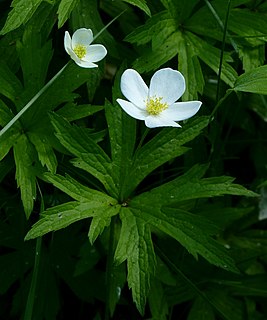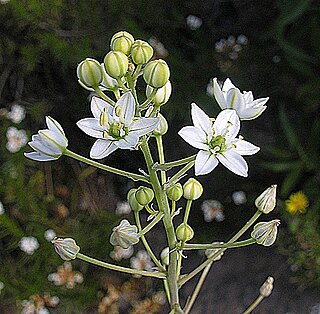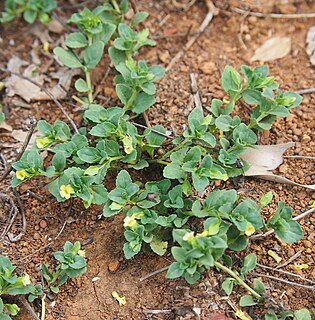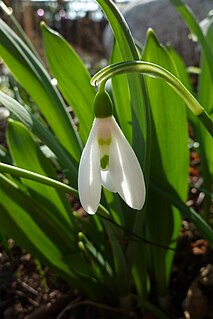
Taiwania, with the single living species Taiwania cryptomerioides, is a large coniferous tree in the cypress family Cupressaceae.

Lycopodium clavatum is the most widespread species in the genus Lycopodium in the clubmoss family.

Microbiota is a monotypic genus of evergreen coniferous shrub in the cypress family Cupressaceae, containing only one species, Microbiota decussata. The plant is native and endemic to a limited area of the Sikhote-Alin mountains in Primorskiy Krai in the Russian Far East. The name causes much confusion because of other meanings for the word "microbiota," but the genus name was derived from micro-, meaning "small," + Biota, the genus name for a closely related conifer, a species formerly called Biota orientalis, now renamed Platycladus orientalis.

Glyptostrobus pensilis, also known as Chinese swamp cypress, is the sole living species in the genus Glyptostrobus. It is native to subtropical southeastern China, from Fujian west to southeast Yunnan, and also very locally in northern Vietnam and Laos.

Cornus canadensis is a species of flowering plant in the dogwood family, native to eastern Asia, the northern United States, Colorado, New Mexico, Canada and Greenland. Unlike its relatives, which are for the most part substantial trees and shrubs, C. canadensis is a creeping, rhizomatous perennial growing to about 20 cm (8 in) tall.

Austrocedrus is a genus of conifer belonging to the cypress family (Cupressaceae). It has only one species, Austrocedrus chilensis, native to the Valdivian temperate rain forests and the adjacent drier steppe-forests of central-southern Chile and western Argentina from 33°S to 44°S latitude. It is known in its native area as ciprés de la cordillera or cordilleran cypress, and elsewhere by the scientific name as Austrocedrus, or sometimes as Chilean incense-cedar or Chilean cedar. The generic name means "southern cedar".

Anemone canadensis, the Canada anemone, round-headed anemone, meadow anemone, or crowfoot, is a herbaceous perennial native to moist meadows, thickets, streambanks, and lakeshores in North America, spreading rapidly by underground rhizomes, valued for its white flowers.

Juniperus procera is a coniferous tree native to mountainous areas in Africa and the Arabian Peninsula. It is a characteristic tree of the Afromontane flora.

Brunfelsia pauciflora is a species of flowering plant in the family Solanaceae, the nightshades. It is endemic to Brazil, and it is grown in cultivation. A shrubby perennial plant grown in gardens, its common names include yesterday-today-and-tomorrow, morning-noon-and-night, Kiss Me Quick, and Brazil raintree.
Callaeum antifebrile is a South American jungle vine of the family Malpighiaceae which occurs predominantly throughout the Upper Amazon basin, and less frequently along the Lower Amazon. Occasionally a component in ayahuasca decoctions, it is used as a folk medicine in some parts of Brazil, often as an antifebrile (anti-fever) remedy.

Iva xanthiifolia, synonym Cyclachaena xanthiifolia, known as giant sumpweed or, in Britain and Ireland, marsh-elder, is a North American plant species in the sunflower family. It is believed to be native to the Great Plains but now found across much of southern Canada and the contiguous United States, though rarely in the Southeast. It has been introduced and semi-naturalized in central and southern Britain, partly via seeds bought for bird food.

Oziroe is a genus of bulbous South American plants in the squill subfamily within the asparagus family. Within the Scilloideae, it is the sole member of the tribe Oziroëeae and the only genus in the subfamily to be found in the New World.

Mecardonia (axilflower) is a genus of herbaceous plants in the family Plantaginaceae. 31 species have been described, of which 12 are accepted. Its distribution is predominantly in South America, and South East United States, including Florida and Alabama but may be found as far north as Virginia. (see map) Five species are found in Argentina and three in the US.

Celtis ehrenbergiana, called the desert hackberry or spiny hackberry, is a plant species that has long been called C. pallida by many authors, including in the "Flora of North America" database. It is native to Arizona, Florida, New Mexico and Texas, and to Latin America as far south as central Argentina. It grows in dry locations such as deserts, brushlands, canyons, mesas and grasslands.
Erythrina flabelliformis, common name chilicote or western coral bean, is a plant species native to central and northwestern Mexico and the southwestern United States. It is known from Baja California as far south as Morelos and as far east as San Luis Potosí, as well as from Arizona and New Mexico.

Persicaria sagittata, common names American tearthumb, arrowleaf tearthumb, or arrowvine, is a plant species widespread in the eastern half of North America as well as in eastern Asia. It has been found in every state and province from Texas to Manitoba to Newfoundland to Florida, plus Colorado and Oregon. It also grows in China, the Russian Far East, Siberia, Korea, Japan, northern India and Mongolia. It grows in moist areas along lake shores, stream banks, etc.
Quercus deserticola is a Mexican species of oaks in the beech family. It grows in central Mexico in the States of Guanajuato, México, Hidalgo, Jalisco, Querétaro, Oaxaca, Sinaloa, Puebla, and Michoacán.

Galanthus elwesii is one of a number of species of the genus Galanthus, herbaceous, perennial, bulbous plants belonging to the family Amaryllidaceae. It is a native of the Caucasus.

Hypericum przewalskii, commonly called Przewalski's St. John's wort, is a flowering plant in Hypericumsect. Roscyna that is native to China.

















